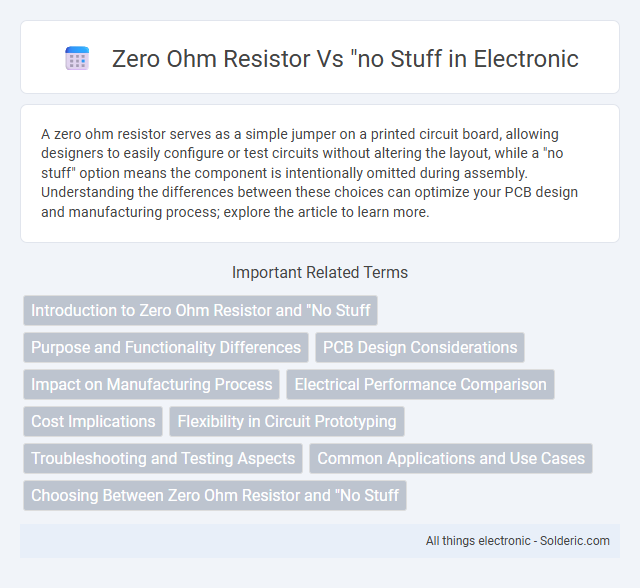A zero ohm resistor serves as a simple jumper on a printed circuit board, allowing designers to easily configure or test circuits without altering the layout, while a "no stuff" option means the component is intentionally omitted during assembly. Understanding the differences between these choices can optimize your PCB design and manufacturing process; explore the article to learn more.
Comparison Table
| Feature | Zero Ohm Resistor | No Stuff (No Component) |
|---|---|---|
| Definition | Resistor with 0O resistance used as jumper | Empty PCB pad with no component installed |
| Functionality | Provides a controlled, solderable jumper | No electrical connection unless PCB traces connect directly |
| Placement | Placed on PCB as a physical component | Pad remains empty, no component placed |
| Manufacturing | Allows automated placement and testing | Simplifies assembly but may complicate testing |
| Flexibility | Used for optional circuit paths or debugging | Used to exclude circuit paths without jumper |
| Electrical Characteristics | Near zero resistance, minimal inductance | Open circuit unless connected by PCB traces |
| Cost | Minimal component cost | Potentially lowers cost by reducing components |
Introduction to Zero Ohm Resistor and "No Stuff
Zero ohm resistors serve as jumper connections on PCBs, providing a simple way to bridge traces without introducing resistance, commonly used for configuration or debugging purposes. "No stuff" refers to PCB assembly areas where components are deliberately omitted, enabling design flexibility or future modifications without altering the board layout. Both techniques optimize circuit design by managing connectivity and adaptability in electronic manufacturing.
Purpose and Functionality Differences
Zero ohm resistors serve as jumper connections on printed circuit boards, enabling flexible circuit design and automated manufacturing without solder bridges. Unlike "no stuff" areas, where components are intentionally omitted to create an open circuit or optional functionality, zero ohm resistors provide a deliberate, low-resistance electrical path. Their functionality differs as zero ohm resistors maintain circuit continuity, while "no stuff" spots introduce intentional gaps or design variations.
PCB Design Considerations
Zero ohm resistors serve as convenient jumper wires within PCB layouts, enabling flexible circuit routing without altering design files. Unlike "no stuff" options where components are omitted entirely, zero ohm resistors maintain electrical continuity while allowing for easy modifications or testing. Your PCB design benefits from this versatility by simplifying assembly and troubleshooting processes without compromising signal integrity.
Impact on Manufacturing Process
Zero ohm resistors streamline the manufacturing process by serving as jumper wires, enabling automated pick-and-place machines to install connections without manual intervention. Using zero ohm resistors reduces the risk of assembly errors compared to "no stuff" or unpopulated pads, which may require manual rework or cause circuit continuity issues during testing. Your production efficiency improves with zero ohm resistors by maintaining standard assembly workflows and minimizing troubleshooting time.
Electrical Performance Comparison
Zero ohm resistors provide a predictable, low-resistance connection typically under 50 milliohms, ensuring minimal signal loss and reliable continuity on the PCB. In contrast, "no stuff" or unpopulated PCB pads eliminate any component presence, reducing parasitic inductance and capacitance to the absolute minimum, which can benefit high-frequency signal integrity. Choosing zero ohm resistors allows easy reconfiguration and troubleshooting, whereas no stuff improves electrical performance by avoiding any insertion loss or impedance changes.
Cost Implications
Zero ohm resistors provide a low-cost solution for PCB trace jumps compared to "no stuff" options that leave placeholders empty and may require manual bridging or rerouting. Using zero ohm resistors reduces labor time and increases automation in assembly lines, minimizing overall production costs. Choosing "no stuff" can save component expenses but often leads to higher rework and testing costs, impacting total manufacturing budget.
Flexibility in Circuit Prototyping
Zero ohm resistors enhance circuit prototyping flexibility by acting as configurable jumpers, allowing easy modification of signal paths without redesigning PCBs. They facilitate quick testing of different circuit topologies and enable selective component inclusion or exclusion during development. Using zero ohm resistors reduces assembly complexity while maintaining precise control over circuit connectivity in iterative design phases.
Troubleshooting and Testing Aspects
Zero ohm resistors simplify PCB troubleshooting by acting as convenient jumpers that can be easily removed or replaced without damaging the board, allowing for isolated testing of circuit sections. Unlike "no stuff" areas, where components are absent, zero ohm resistors maintain circuit continuity, providing definitive test points for diagnosing faults. Your testing process benefits from the stable presence of zero ohm resistors, which ensures accurate signal paths and simplifies fault localization.
Common Applications and Use Cases
Zero ohm resistors serve primarily as configurable jumpers on printed circuit boards, facilitating circuit design flexibility and simplifying manufacturing testing processes. They are commonly applied in communication devices, consumer electronics, and automotive circuits to enable easy reconfiguration without altering PCB layouts. In contrast, a "no stuff" or "no populate" approach is used to omit components deliberately, allowing cost reduction or selective feature enablement in large-scale production runs.
Choosing Between Zero Ohm Resistor and "No Stuff
Choosing between a zero ohm resistor and "no stuff" depends on PCB design flexibility and manufacturing preferences. Zero ohm resistors act as programmable jumpers, enabling future modifications or testing without redesigning the board, while "no stuff" indicates a deliberate omission of components to save cost or space. Engineers prioritize zero ohm resistors for design adaptability and trace continuity, whereas "no stuff" suits fixed, cost-sensitive applications with no anticipated changes.
Zero ohm resistor vs "no stuff Infographic

 solderic.com
solderic.com